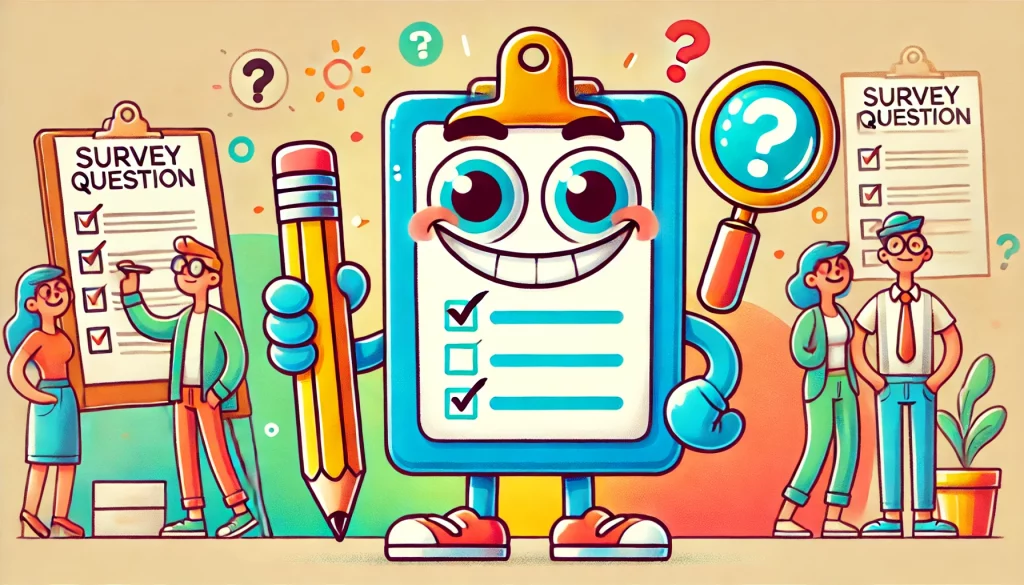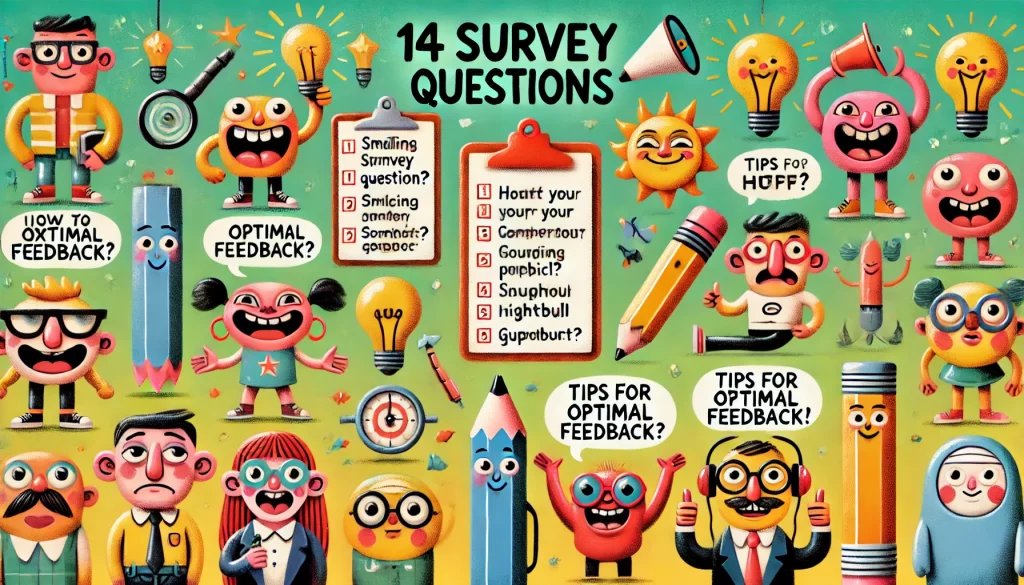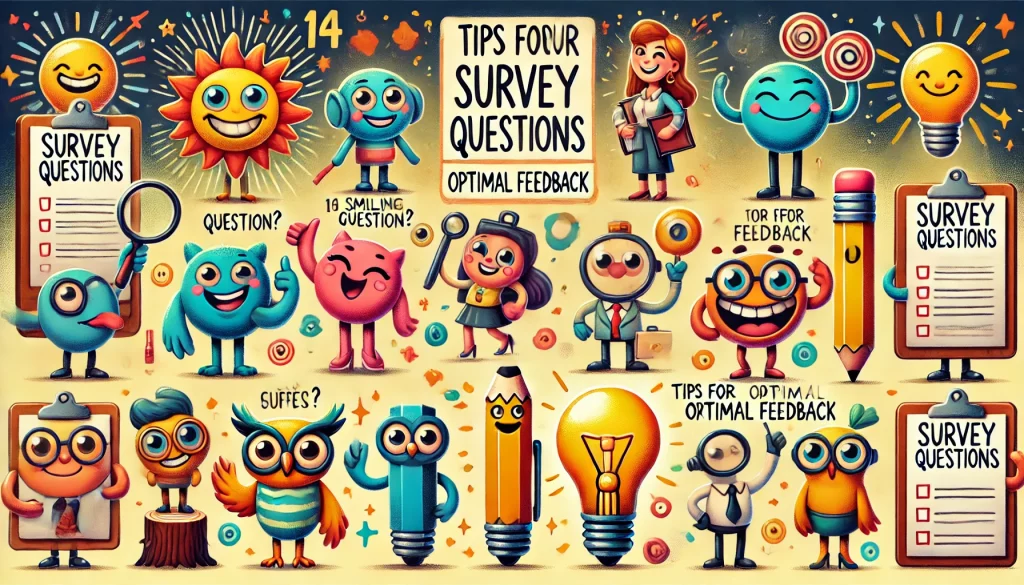Survey questions examples for optimal feedback: boost your insights today

Understanding the purpose of surveys
Surveys are a crucial tool for gathering information and opinions from a targeted audience. They enable businesses, researchers, and organizations to make data-driven decisions, identify trends, measure satisfaction levels, and understand customer preferences.
By crafting appropriate survey questions, valuable data can be collected to gain insights into the thoughts, behaviors, and experiences of your audience.
Choosing the right survey methodology
Before diving into specific survey questions, selecting the right survey methodology that aligns with your goals is essential. Common survey methods include online surveys, phone interviews, in-person questionnaires, and focus groups.
Each method has its advantages and limitations, so consider your target audience, budget, and the type of data you wish to collect when choosing a methodology.
Types of surveys
Surveys are versatile tools for collecting feedback, but no one-size-fits-all approach exists. Depending on the stage in the buyer’s lifecycle, companies use different types of surveys to capture various types of feedback. Common types of surveys include:
Product surveys
These help companies learn what users think about their products. Conducting surveys before launching a product helps identify what people want and need. For existing products, surveys reveal how customers enjoy their experience and suggest areas for improvement.
Customer experience (cx) surveys
These collect constructive feedback about customer experiences at different touchpoints. Types of CX surveys include Customer Satisfaction Surveys (CSAT), Net Promoter Score Surveys (NPS), and Customer Effort Score (CES).
Brand and marketing surveys
These help articulate brand positioning and develop messaging that resonates with future customers. Crafting effective questions is crucial for getting a strong response rate.
Benefits of customer surveys
Designing effective survey questions requires careful consideration of the survey’s purpose, the target audience, and best practices in question design. Here are the top three benefits of conducting customer surveys and how they can unlock valuable insights for your business.
Get valuable customer feedback
Customer satisfaction survey responses provide critical feedback on any concerns your customers may have. Depending on how you structure your questions, you can determine how satisfied your customers are with your business.
Open-ended questions can allow them to express reasons behind their satisfaction levels and elaborate on their answers. Use this feedback to identify opportunities to improve the customer experience and capitalize on them.
Retain customers
The results from a customer satisfaction survey can alert you to which customers are unhappy and likely to churn. If customers are satisfied with their experience, they’re more likely to stay with your business.
However, if survey results indicate dissatisfaction, they may choose your competitors. Reaching out to unhappy customers and taking steps to mend the relationship can improve your retention rate.
Identify strengths and weaknesses, involve customers in product ideation, and assess brand perception and loyalty.
Helps you understand your customers
Understanding customers on a holistic level, beyond just their interactions, is crucial for achieving high ratings. Compare their experiences with those of competitors, analyze areas needing improvement, and regularly collect reviews to identify patterns.
A deeper understanding of customers drives informed decision-making and enhances the customer experience.

Customer experience survey questions examples
How was your experience with us today?
This common question determines the customer satisfaction score (CSAT). To calculate your CSAT score, divide the number of satisfied customers by all respondents and multiply by 100.
What could we have improved on/done better?
This follow-up question on a CSAT survey helps understand the quality of customer experiences and highlights areas for improvement.
How would you explain our product/service to a friend, family member, or colleague?
This open-ended question provides insights into how customers perceive your offerings and can inform your marketing messaging.
How likely are you to recommend our business?
This foundational question for the NPS system gauges customer loyalty and its connection to revenue growth.
Brand and marketing customer survey questions examples
How did you hear about us?
Understanding how customers learn about your business helps identify channels driving the most traffic and ROI.
How would you search for our business on google?
This helps identify new keywords that lead to customer acquisition and informs your inbound SEO strategy.
What is the primary reason you chose us over competitors?
Discovering what sets your product or service apart provides valuable competitive intelligence.
Could you easily find the information you were looking for on our website?
This question helps assess the user experience on your website and identify areas for improvement.
What’s one thing you love about our company?
Understanding what customers love about your company helps you build on strengths and preferences.
Do you have suggestions?
Asking for suggestions proactively helps identify gaps in your offerings and potential advocates.
Increase your response rate with smart surveys
Asking the right questions is essential for obtaining valuable customer feedback. Equally important is providing an intuitive survey experience.
Implementing Pulse Surveys can innovate the traditional survey experience, boosting conversion rates to 50%. Text surveys achieve better open and response rates than emails.
Use conditional logic to customize the survey path based on respondents’ answers.
Tips for writing effective survey questions
To ensure your survey questions yield accurate and meaningful results, follow these best practices:
Craft clear, concise, and easy-to-understand questions.
Avoid technical jargon or complex language.
Ensure balanced response options for multiple-choice or rating scale questions.
Arrange questions logically to maintain flow and avoid influencing responses.
Avoid combining multiple ideas in one question.
Gather feedback from a small group to identify areas for improvement.
Pro tip: Long surveys can lead to survey fatigue and lower response rates. Keep surveys short, focused, and relevant to maximize participant engagement and completion rates.

Drag’n survey: customer satisfaction survey
Overall satisfaction
Asking customers about their overall satisfaction helps gauge the general perception of your product or service. This question typically asks how satisfied they are on a scale from 1 to 10, providing a quick snapshot of customer sentiment.
Product/service quality
Inquiring about the quality of the product or service can highlight areas for improvement. This question might focus on various aspects such as durability, reliability, and performance, helping to identify specific areas that need attention.
Customer service experience
Understanding customer service interactions is crucial. Questions might address the friendliness, knowledge, and efficiency of support staff, which can help improve training and processes.
Likelihood to recommend
The Net Promoter Score (NPS) question asks how likely customers are to recommend the company to others. This measure helps predict future growth and customer loyalty.
Problem resolution
Asking customers if their problems were resolved satisfactorily can reveal insights into the effectiveness of your support processes. This question assesses both the resolution and the speed of service.
Value for money
Determining if customers feel they are getting value for their money can identify pricing or product issues. This question helps ensure your offerings meet customer expectations regarding cost versus benefits.
Usability
Inquiring about the ease of use of your product or service can uncover potential usability issues. This question is especially important for tech products or services where user experience is key.
Features and functionality
Asking customers to rate the features and functionality helps prioritize product development. It can identify which features are most valued and which may need enhancement.
Comparison to competitors
Understanding how customers view your product or service compared to competitors can provide a competitive edge. This question helps pinpoint strengths and weaknesses relative to the market.
Customer expectations
Checking if your product or service meets customer expectations can guide improvements. This question ensures that marketing promises align with actual customer experiences.
Stova: post-event survey
Event organization
Asking attendees about the organization of the event provides feedback on logistics. This can include aspects like registration, information dissemination, and venue arrangements.
Content relevance
Understanding if the event content was relevant and valuable helps tailor future events to audience needs. This includes sessions, speakers, and topics covered.
Speaker effectiveness
Evaluating speakers’ performance can help in selecting future speakers. This question addresses aspects like clarity, engagement, and expertise.
Networking opportunities
Assessing the quality and quantity of networking opportunities can improve attendee satisfaction. This question helps gauge the effectiveness of networking sessions or events.
Technology and tools
Inquiring about the effectiveness of technology and tools used during the event can highlight areas for improvement. This includes event apps, virtual platforms, and audiovisual aids.
Session length
Feedback on session length can help in scheduling future events. It ensures that sessions are neither too long nor too short, keeping attendees engaged.
Event communication
Evaluating pre-event and on-site communication can improve attendee experience. This includes emails, signage, and announcements.
Sparkbay: professional development survey
Professional growth
Employees’ perception of their professional growth within the company helps assess the effectiveness of development programs. This question checks if employees feel they are advancing in their careers.
Company support
Inquiring how the company can better support professional growth can uncover new development opportunities. This includes training, mentorship, and resources.
Challenging work
Understanding if employees find their work challenging can reveal engagement levels. This question ensures that

Expert opinions on review management for lawyers and attorneys
Sarah Patel, Market Research Analyst: “Survey questions should be tailored to the target audience. For B2B surveys, a question like ‘How has our service impacted your business operations?’ is more relevant than general satisfaction queries. Tailored questions provide more actionable insights relevant to the specific context of the respondent.”
John Michaels, Digital Marketing Expert: “Including a Net Promoter Score (NPS) question, such as ‘How likely are you to recommend our product to a friend or colleague?’ is essential for gauging overall customer loyalty. NPS is a powerful metric that helps predict growth through customer advocacy.”
Lisa Huang, UX Researcher: “To improve user experience, it’s beneficial to include task-specific questions like, ‘How easy was it to navigate our website?’ This type of question helps identify specific pain points in the user journey, allowing for targeted improvements.”

 9 min
9 min 







